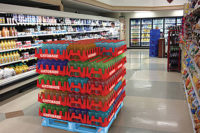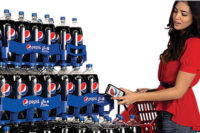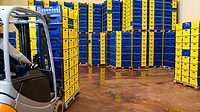Although it might not have been a requirement 10 years ago, good brands today will need to make a genuine commitment to sustainability moving forward, says Trent Overholt, vice president of supply chain solutions for Los Angeles-based Rehrig Pacific Co. The buzzword “sustainability” can have many different applications in the beverage industry including environmental and economic sustainability. According to experts, reusable containers can help companies commit to sustainability on both of these counts.
IFCO Systems, which operates a pool of more than 140 reusable plastic containers (RPCs) globally, reports that RPCs produce approximately 95 percent less waste than corrugated boxes. The Houston-based subsidiary of Sydney-based Brambles Ltd. explains that RPCs require approximately 39 percent less energy on average than corrugated boxes because this energy is allocated throughout its many use cycles. Although both types of packaging are recycled at the end of their life cycles, corrugated boxes often are used only once and then discarded, while RPCs are used more than once, it adds.
Rehrig Pacific’s Overholt says that although pad shrink, tray shrink and other expendable containers that rival RPCs are recyclable, they require more energy to recycle them than it takes to manufacture them out of virgin materials. “With the reuse model, you manufacture it once,” he says.
Although the reuse model offers ecological sustainability benefits, Rehrig Pacific’s Overholt notes that the option can pose some logistical issues with returning the container to the starting point. Because of this, the reusable container model tends to be more successful in direct-store-delivery models, because the truck that delivers the containers will return to the starting point with the containers anyway without incurring additional costs, he says.
Similarly, customers that a company ships to on a regular basis make great candidates for reusable containers because of the frequency of contact and easy return logistics, says Dan Huhn, new product development manager for Milford, Ohio-based Buckhorn Inc.
Once in the truck, reusable containers can help conserve space on both the delivery and return trips. For example, Buckhorn’s new 60-gallon reusable drum, which has a 24- by 20- by 40-inch footprint, can interlock with three other drums to form a 48- by 40-inch pallet and can be stacked up to five drums high, the company says. This means that the drum offers 25 percent better cube utilization than standard 55-gallon drums, considering that the volume contained by four of the 60-gallon drums would require five 55-gallon drums, it says. For the return trip, the hinged sidewalls allow the container to fold flat to conserve space, Buckhorn says. In fact, 480 collapsed drums fit in a 53-foot truck for a three-to-one return ratio, it adds.
Similarly, Oconomowoc, Wis.-based Orbis launched in April its new FP143 FliPak container, which features a snap-on lid, stacks when full, and nests when empty to conserve truck space, the company says. By maximizing trailer load space on delivery and return trips, companies can in turn increase their return on investment with reusable containers, says Albert Seecharan, president of Orbis’ reusable packaging management services.
Companies also can maximize their reusable container usage by utilizing them as retail-ready display cases as well. Chep USA, Orlando, Fla., released in March its Retail Beverage Tray as a reusable, sustainable retail solution. Designed to carry 1.25-, 1.5-, 2- and 2.25-liter bottles, the new container streamlines the delivery process and expands container use by allowing brands to deliver and sell their products directly out of the container. Plus, it eliminates the steps of handling perforated packaging and managing cardboard waste in the delivery process, the company says.
With these advantages, reusable containers offer a strong option for sustainability, Rehrig Pacific’s Overholt says. “The cost per trip is quantifiably better,” he says. “It’s more sustainable, and as companies are challenged to become more sustainable, become more aware of their carbon footprint, and make meaningful steps to improve that, that is going to give them an additional push to look at investing in a reusable packaging system versus a one-way, throw-away, throw-it-out-and-forget-it type of system.”
The safety factor
The trade-off with reusable containers is that they need to be maintained between uses, including cleaning, inspecting and repairing containers to ensure safety for the whole supply chain.
Buckhorn’s Huhn says that the cleaning aspect gives users more control over the cleanliness of their containers. For example, while expendable containers pose a contamination threat, reusable containers are specifically designed to avoid contamination, he says.
“Knowing that you’re using a container that’s going to be used in either a direct or indirect food application, you’re designing it so that you don’t have a whole lot of nooks and crannies where bacteria, dirt and contamination can grow,” Huhn says. “We’re designing containers that really have smooth interiors, smooth exteriors, and big radiuses on the corners so that they can be easily cleaned.”
For added protection, some containers also can be equipped with tamper-evident features, Huhn says. For example, Buckhorn’s 60-gallon drum’s lid has holes for security ties to help maintain product integrity, the company says.
In addition, Orbis now offers a new X-ray feature for its RackoCell reusable pallets for improved product safety, Seecharan says. In the event that any piece of the pallet comes loose because of aggressive handling, the material will be detected as the product passes through an X-ray system prior to outbound shipping and removed, he explains.
As part of good reusable container maintenance, Rehrig Pacific provides a service for washing the containers and putting them through maintenance inspections to check for anything that would create a functional issue so that the containers can be used again, Overholt says. Due to the quality of materials used on these reusable assets, damage rates are relatively low, he adds.
However, one common source of damage to reusable containers is how a forklift handles them, Buckhorn’s Huhn explains. “Any time it’s the forklift versus the packaging, the forklift always wins,” he says.
Some Buckhorn customers report that their reusable containers last up to 15 years when handled properly, Huhn says. “They’re the ones who have taken the time to explain to their forklift drivers, ‘Hey, this is an important asset to us. You need to slow down and make sure you’re picking it up and handling it the right way,’” he says.
Search and rescue
As an asset that makes its way around the supply chain multiple times a year for many years, container loss, theft and damage can be a challenge with reusable containers, experts note.
“You can imagine if we sell someone a plastic pallet and they lose 70 percent of them by the end of the year, it’s going to be hard to get a good return on investment,” Rehrig Pacific’s Overholt says. If the return on investment is low, customers may choose to switch back to expendable packaging, he notes.
To protect company investments in these reusable products, companies in the reusable container industry have come up with a plethora of ways to keep an eye on where these assets are at all times.
Buckhorn’s Huhn says tracking is a multi-player process. “The biggest success in reusable packaging is having both parties involved in the decision-making and the planning of the process, having the shipper and the receiver work together to make this work,” he says.
Barcode scanning, radio-frequency identification (RFID) tags and third-party logistics services are commonly used to track these assets, Huhn notes. By knowing where these assets are in the supply chain, customers are better able to close the loop and be more sustainable, he says.
Orbis also offers its SmartTrak customized asset management software, which is designed to track, manage and provide visibility for all reusable packaging, including sheets, top frames, pallets and totes, Seecharan says. It also helps companies make instant, strategic decisions about how to replenish and move packaging when and where it is needed to add efficiency to the industry pool. Additionally, it provides reports and packaging event notifications to keep management teams in the loop, according to the company’s website.
Although reusable kegs take advantage of some of these tracking methods, they can be regulated in other ways, says Barb Wirth, corporate communications manager for Satellite Logistics Group (SLG), Houston. For example, certain kegs are embossed, banded or striped in specific colors and band widths to signify a specific brand or producer, she says. In other cases, the kegs are associated with a deposit that is refunded when the keg is returned, which gives the user more incentive to return the keg to the owner, she adds.
To facilitate the keg tracking process, SLG offers its proprietary Kegspediter program for importers and domestic producers. The program collects empty kegs, segregates any kegs in need of repair, and returns the kegs to the brewers frequently and quickly, thus reducing the number of kegs required to meet production needs, Wirth says. Because Kegspediter monitors the kegs throughout the supply chain, it also helps reduce loss and theft, she adds.
In other cases, problematic return situations can be the determining factor for tracking type. For example, if a company notices that it is missing containers, it can send in a container with a GPS tag to determine where the containers are going after delivery, Rehrig Pacific’s Overholt says. These GPS tags, which do not require a reader, can be set to transmit a signal to the home base daily to report its location, he explains. This can help the company find the kink in the supply chain loop and even recover missing pallets, he says.
More than keeping track of where the assets are at all times, tracking also helps companies boost efficiency by ensuring products are delivered on time and that the containers are returned to the point of origin, Buckhorn’s Huhn says.
“The key with reusable packaging is closing the loop, being able to get those containers back after they’ve been used so that I can clean them, refurbish them and reuse them again; that’s the critical driver,” Huhn says.
Targeting consumers
Because reusable containers stay with a company through multiple cycles and even multiple years, particularly when they are well tracked, reusable container manufacturers are able to invest in high-quality material and even some customizable features for marketing benefits, according to Trent Overholt, vice president of supply chain solutions for Los Angeles-based Rehrig Pacific Co. “Over the years, we’ve made the designs more aesthetically pleasing and something that’s nice for the consumer to shop out of,” he says. As a branded merchandising asset, Rehrig Pacific can enhance the reusable container with brand colors and a logo and form scallops on the container edges for better label facing, he says.
The added level of branding in merchandising can help consumer packaged goods companies take advantage of consumer shopping behavior, Overholt says.
According to Chicago-based Point of Purchase Advertising International’s “2012 Shopper Engagement Study,” 76 percent of consumer purchasing decisions are made in-store. “Often the decision-making process of shoppers does not occur until they actually see a product in the store,” it states. “Therefore, the way a product is displayed in a store and is supported by in-store marketing materials can often be instrumental in leveraging sales.”
Rehrig Pacific joined forces with Clemson University, Clemson, S.C., to test how the in-store marketing features of their reusable containers impacts in-store attention and decisions. The study measured eye fixation and fixation duration as a measure of consumer attention toward and interest in displays featuring branded and non-branded reusable containers. According to the company’s 2013 white paper, “Visual Attention to In-Store Marketing,” statistical analysis demonstrated a 47 percent increase in eye fixations on the branded display and a 34 percent increase in fixation duration when compared with a non-branded container of the same color. In addition, when displayed in a branded reusable container, consumers showed an increase of eye fixations on the primary product, which in this case was a 2-liter, carbonated-soft-drink bottle, by 56 percent and an increase in fixation duration by 54 percent. This increased brand attention also can lead to increased purchasing, Overholt adds.
Considering that companies invest in advertising so that consumers are familiar with their brands, reusable containers used as in-store displays should help brands catch consumers’ eyes on the shelf, Overholt says. “Our packaging does a better job of bringing the eye to their label, to their brand — the one that [consumers] know, trust and love — and inspiring them to buy,” he says.








